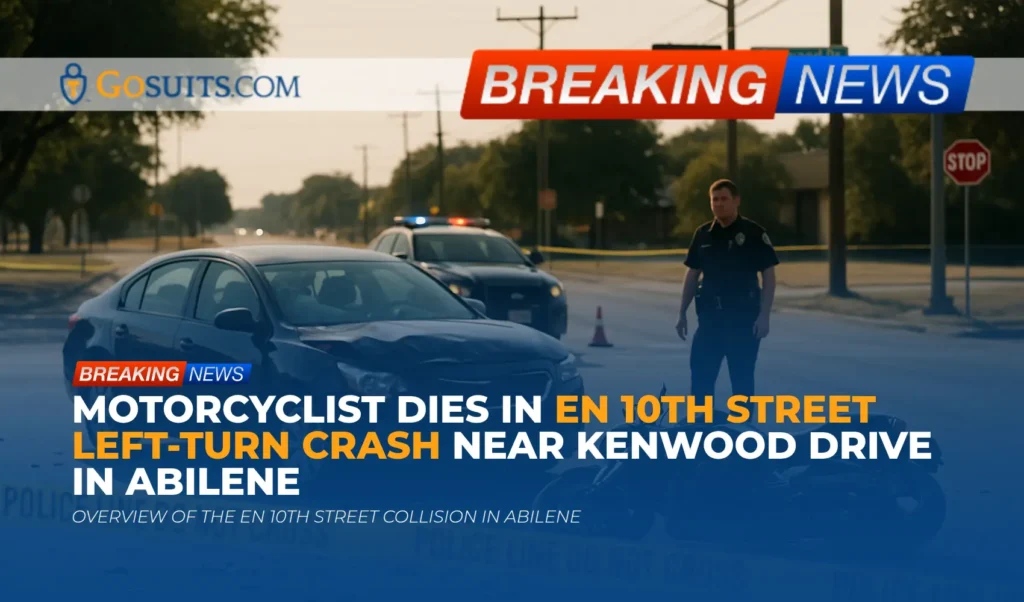- Reported collision on State Highway 71 near Pace Bend Road in Spicewood
- What authorities reported so far
- What information is not yet available
- Immediate health and safety steps after a highway collision
- How to obtain official records and updates
- Legal context in Texas for injury and wrongful death claims
- Insurance coverage and practical considerations
- Preserving evidence and documenting losses
- Safety context and data for high-speed Texas corridors
- Credible government resources for updates and support
- Commentary from Gosuits Spicewood, Texas Personal Injury Attorney
- Time-sensitive next steps
Reported collision on State Highway 71 near Pace Bend Road in Spicewood
Early Thursday morning, a traffic collision led authorities to close both directions of State Highway 71 near Pace Bend Road in Spicewood, Texas. According to the Travis County Sheriff’s Office, the crash was reported at approximately 7:41 a.m. The Texas Department of Transportation indicated that both eastbound and westbound lanes were shut down following the incident and were reopened around 9 a.m. At the time information became public, officials had not released details about any injuries.
This corridor serves commuters and residents in western Travis County and beyond. Any closure on SH 71 can cause a significant ripple effect on morning travel. When lanes reopen within a couple of hours, it typically reflects that first responders completed immediate scene safety measures, preliminary investigation steps, and debris or hazard removal. Even so, a collision at that time and place can leave lasting physical and emotional impacts for those involved.
What authorities reported so far
Location and timing
Authorities reported the crash near Pace Bend Road on State Highway 71 in the Spicewood area of Travis County. The initial report time was 7:41 a.m., a period of increased traffic volume for school and work commutes. Lanes in both directions were closed for roughly an hour and twenty minutes, with reopening reported around 9 a.m.
Agencies involved
The Travis County Sheriff’s Office is the primary law enforcement agency that reported the incident. The Texas Department of Transportation, which manages state highways, provided lane status updates related to the closure and reopening. Fire and EMS typically respond to collisions of this nature for traffic control, medical assessment, and hazard mitigation.
Injuries and vehicles
As of the latest public update, no information had been released regarding injuries or the number and type of vehicles involved. When information is limited, it is common for agencies to verify facts and complete certain investigative steps before issuing more detailed public statements.
What information is not yet available
When a crash is first reported, details often remain limited. The following points were not yet publicly available:
- Cause of the collision such as distraction, speed, failure to yield, impairment, or hazardous road conditions.
- Vehicle count and whether commercial vehicles were involved.
- Injury details or confirmation of fatalities.
- Preliminary fault assessment or citations, if any.
These details typically emerge through official crash reports and, if applicable, follow-up public information releases. Families often find it helpful to request the official records discussed below to understand what happened.
Immediate health and safety steps after a highway collision
Crashes on high-speed roadways can cause hidden injuries. Even if symptoms feel mild at first, a medical evaluation can help identify concussion, internal injury, or soft tissue harm that may not be obvious in the moment. The National Highway Traffic Safety Administration offers straightforward guidance on what to do after a crash, including seeking medical care, documenting the scene when safe, and exchanging information with other drivers. See NHTSA’s resource on post-crash steps at What to do after a crash.
If a collision results in a fatality, responding agencies will coordinate with the county medical examiner for next-of-kin notification and further investigation. In Travis County, that is the Travis County Medical Examiner’s Office, discussed further below.
How to obtain official records and updates
Different records serve different purposes. Official documents can help families understand the facts, manage insurance claims, and make informed decisions about next steps.
Crash report (Texas Peace Officer’s Crash Report, CR-3)
A Texas Peace Officer’s Crash Report, often called a CR-3, is the official state form completed by law enforcement after qualifying collisions. The Texas Transportation Code governs how these reports are released. Eligibility to obtain a crash report and rules for redactions are set out in Transportation Code § 550.065.
Crash reports are maintained through the Texas Department of Transportation. TxDOT’s public-facing resources explain how eligible parties can request copies through the Crash Records Information System. For district-level roadway and contact information, see the TxDOT Austin District.
Helpful points when requesting a CR-3:
- Have the date, time, and location of the crash and the investigating agency.
- Eligible requestors typically include a person involved, their authorized representatives, and some insurers, consistent with § 550.065.
- Processing times vary. It can take days or weeks before a report is finalized and available.
Incident report or call-for-service details from the Travis County Sheriff’s Office
The Travis County Sheriff’s Office provides public information consistent with Texas transparency laws. General information is available at the agency’s website: Travis County Sheriff’s Office. To request records, residents can use the county’s public information request channel outlined at Travis County Public Information Requests.
When requesting records, include:
- Date and approximate time of the collision.
- Location near Pace Bend Road and SH 71, Spicewood area.
- Nature of the record sought such as incident report, CAD notes, or any available supplemental narrative.
Autopsy report and death certification if a fatality is confirmed
If a collision results in loss of life, the county medical examiner evaluates the cause and manner of death. In Travis County, information about autopsy reports and the process for requesting copies is available through the Travis County Medical Examiner’s Office.
Certified copies of death certificates in Texas are issued through the Department of State Health Services, Vital Statistics Section. Applications and eligibility rules are detailed at Texas DSHS Vital Statistics.
Legal context in Texas for injury and wrongful death claims
Each collision has its own facts. The information below provides general Texas background that can help families understand potential civil claims. This is educational and not tailored to any specific case.

Negligence and proportionate responsibility
In most traffic cases, liability turns on whether a driver failed to use ordinary care, such as by speeding, following too closely, improper passing, distraction, or impairment. Texas follows a proportionate responsibility system, which can reduce or bar recovery if a claimant shares fault. The framework is set out in Civil Practice and Remedies Code Chapter 33. If a claimant’s responsibility is found to be more than 50 percent, recovery is generally not permitted under that statute.
Investigations often review physical evidence, vehicle damage profiles, skid or yaw marks, electronic data from vehicles, witness statements, and any available traffic or business camera footage. Early collection of this material is critical, as some data can be overwritten or lost.
Time limits to file civil claims in Texas
Texas law imposes deadlines for filing civil injury and wrongful death claims. In many motor vehicle cases, the general limitations period is two years. See Civil Practice and Remedies Code § 16.003. Certain circumstances can change timing, including claims involving governmental units or minors. Because deadlines can be strict, timely consultation can help protect rights.
Wrongful death and survival actions
If a crash causes a death, Texas provides for wrongful death claims by specific family members and for a survival claim on behalf of the decedent’s estate. Eligibility and categories of damages are addressed in Civil Practice and Remedies Code Chapter 71. These statutes outline who may bring claims and the types of losses that may be considered, such as loss of companionship and mental anguish in appropriate cases.
Insurance coverage and practical considerations
Auto insurance is the primary source of compensation in most traffic collisions. Understanding coverage types helps families navigate claims more effectively.
Minimum liability requirements in Texas
Texas law sets minimum financial responsibility for drivers at 30/60/25, meaning at least $30,000 for bodily injury per person, $60,000 per crash, and $25,000 for property damage. See Transportation Code § 601.072. Many drivers carry higher limits. Additional coverages may include personal injury protection, medical payments, uninsured or underinsured motorist coverage, and collision or comprehensive for vehicle repairs.
Speaking to insurance companies
Claims adjusters often request recorded statements soon after a crash. What someone says can be used later in the claims process. Before speaking with any insurer, it is prudent to consult with a qualified attorney for a free consultation to understand rights and obligations. Be aware that brief summaries given under stress can be incomplete or misunderstood. Written, carefully documented information tends to be more accurate.
Property damage, rental, and towing
Property damage components usually include repair estimates, total loss valuations, towing and storage charges, and rental or loss-of-use claims. Keep receipts and documentation for all expenses. Photograph the vehicle from multiple angles before repairs or disposal, and obtain repair invoices and parts lists.
Preserving evidence and documenting losses
Evidence can fade quickly after a highway collision. Prompt documentation helps ensure a clearer picture of what happened and how it affected those involved.
- Medical records and symptom tracking: Seek evaluation promptly and follow provider instructions. Track symptoms, medications, and activity limitations over time.
- Scene and vehicle photos: If safe, document damage, road conditions, signage, debris, and any skid marks. Preserve photos with dates.
- Witness information: Record names, phone numbers, and brief summaries of what witnesses observed.
- Vehicle data: Modern vehicles may store speed, braking, and other data. Prompt steps may be needed to secure this information before it is lost.
- Employment records: Maintain pay stubs, schedules, and notes about missed work or altered duties due to injuries.
- Personal impact notes: Journaling day-to-day pain levels, sleep disruption, and activities you can no longer do helps professionals understand non-economic harm.
Safety context and data for high-speed Texas corridors
High-speed corridors like State Highway 71 can see serious collisions due to speed differentials, merging maneuvers, and heavy commuter volume. Risk increases where traffic enters from county roads and driveways, especially in low-light or glare conditions common during morning hours.
Federal safety guidance consistently highlights speed and distraction as major contributors to crash severity. NHTSA’s public materials describe how even modest increases in speed can significantly raise the likelihood of serious injury or death, and they provide recommendations for safer driving behavior in these environments. See NHTSA’s overview on speeding and crash risk.
At the state level, TxDOT’s district pages provide information on roadway projects, traffic operations, and safety initiatives that can influence conditions on SH 71. For district contacts and programs, consult the TxDOT Austin District.

Credible government resources for updates and support
When searching for reliable information after a crash, it helps to use official public sources and to keep a record of each update. The following resources are credible starting points:
- Travis County Sheriff’s Office: Agency updates, non-emergency contact information, and links for public information requests can be found at the TCSO website.
- TxDOT Austin District: Roadway project information and general district contacts are available via TxDOT.
- Crash report availability and rules: Eligibility and confidentiality for crash reports are set by Texas Transportation Code § 550.065.
- Autopsy and medicolegal death investigation: The Travis County Medical Examiner’s Office provides information about autopsy reports and processes for next-of-kin.
- Vital records: Death certificates and certified copies are handled through Texas DSHS Vital Statistics.
- NHTSA safety guidance: Post-crash steps and safety tips are available at NHTSA.
For those navigating property damage or claims denials, informational materials are also available from the Texas Department of Insurance, including consumer guides and complaint processes. See the department’s consumer resources at Texas Department of Insurance.
Commentary from Gosuits Spicewood, Texas Personal Injury Attorney
Our hearts go out to everyone affected by the collision on SH 71 near Pace Bend Road. Morning crashes can be disorienting and frightening, especially in a busy commuting window. This article is intended for general education and to offer practical steps while official information develops.
From a personal injury perspective, early clarity matters. Determining how and why a crash happened can depend on prompt preservation of evidence, thorough review of the Texas Peace Officer’s Crash Report, and careful attention to medical findings in the hours and days following the event. When information is limited at the outset, it is best not to draw conclusions. Instead, we encourage a measured approach focused on health, documentation, and understanding the legal framework that may apply in Texas.
Insurance carriers and large corporate interests often control key information in the days after a collision. Adjusters may seek statements before all facts are known, and property damage decisions can be made quickly based on partial data. This can disadvantage individuals who are still processing the event, seeking care, or waiting for the official crash report. Being cautious about recorded statements and authorizations, and understanding how Texas proportionate responsibility rules work, can help prevent avoidable missteps.
A free consultation with a seasoned professional before engaging in detailed communications with an insurer can be beneficial. It can help clarify what documentation is needed, how to avoid common pitfalls, and what timelines may affect a claim under Texas law, including the two-year limitations framework described in § 16.003. This kind of conversation can also address questions about wrongful death eligibility under Chapter 71 and comparative fault under Chapter 33, without making assumptions about any specific case.
Time-sensitive next steps
- Prioritize medical evaluation. Even if symptoms seem minor, prompt care can detect injuries that are not immediately obvious and creates an accurate record tied to the event date.
- Secure official records. Track the investigating agency and request the CR-3 crash report when available. If the collision involved a fatality, note the medical examiner case number for future records requests.
- Preserve all evidence. Save photographs, dash camera footage, repair invoices, towing bills, and damaged property. Ask towing or storage facilities to hold the vehicle until documentation is complete.
- Document time and financial impacts. Keep pay stubs, time-off records, out-of-pocket medical costs, and receipts for transportation and prescriptions.
- Be cautious with insurer communications. Before giving recorded statements or signing medical authorizations, consult an attorney for a free case discussion. Statements can affect how a claim is evaluated and may be used later.
- Note key legal timelines. Texas imposes strict filing deadlines that can vary by claim type and parties involved. Early planning helps avoid last-minute pressure and preserves options.
- Care for emotional well-being. Collisions can be traumatic. Seek support through healthcare providers and trusted community services. Early attention to mental health often improves recovery.
Acting on these steps promptly can improve access to records, prevent the loss of critical evidence, and provide a clearer understanding of available paths forward. Timing is often important because vehicles are repaired or salvaged quickly, digital footage can be overwritten, and memories fade. Taking organized, early action helps ensure that the facts are preserved and that future decisions are informed by the best available information.






